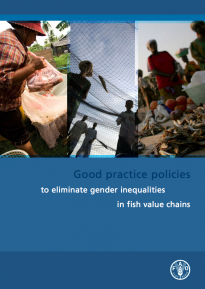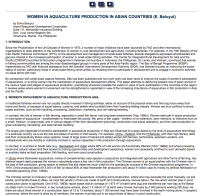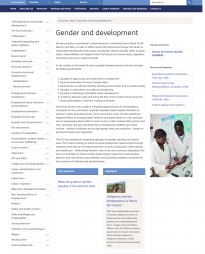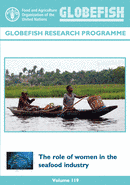Equitable Social and Gender Environment for Misuse of Veterinary Drugs
Gender is important because men and women often perform different tasks within fish value chains, and have different assets, skills, experience, knowledge and decision-making roles. However, the invisibility of women’s roles in official fisheries and aquaculture statistics, coupled with the negative impacts of gender-blind policies, leave women facing discrimination and marginalization within the sector. Attention needs to be given to equal access to productivity-enhancing innovations that improve the overall productivity and quality of products.
The needs of women should be reflected in service delivery such as capacity building in best management practices.
Role of Women in Fish Farming in Asia
Role of Women in Fish Farming in Asia
In Asia, the role of women in fish farming, especially in small fish farms, has long been predominant. Women take part in actual production in most types of aquaculture - brackishwater or freshwater fish ponds, fish pens or fish cages - whether on an extensive, semi-intensive, or intensive level on a small, medium, or large scale, and in various stages of fish farm development (planning, construction and actual operation), and from seed production to grow-out/rearing, harvesting, and post-harvest handling.
China, Thailand, and the Philippines, with their high literacy rates and their comparatively liberal value systems, boast of large pools of trained and skilled women fish farmers, technicians, extension workers, and professionals who are directly or indirectly involved in various capacities in fish production through aquaculture. In contrast, in countries in South Asia (e.g., Bangladesh and India) where 90% of rural women are functionally illiterate and where prevailing social and cultural values limit their access to training opportunities and development assistance, women are necessarily confined to such domestic-based or auxiliary tasks as feed preparation, fish feeding, and even pond construction.
With increasing emphasis placed on aquaculture as an alternative source of fish protein and employment for the masses of Asia, the present role of women can be greatly expanded - both in terms of increased recruitment into the industry and of greater participation within the sector. With the support of local and national governments, and assistance from multilateral aid agencies and international organizations, the problems of rural communities in general, and of rural women in particular, can be more adequately and directly addressed by means of well-planned projects which put emphasis on manpower development at the grassroots level.
Key Publications
Good practice policies to eliminate gender inequalities in fish value chains This publication highlights key gender inequalities in fisheries and aquaculture value chains that lead to underperformance by women, and proposes good practice policies that can influence increases in production and processing of high-quality fish. | |
Women In Aquaculture Production In Asian Countries This paper attempts to define the role of Asian women in the various stages of aquaculture production, and reviews areas where women's involvement can be strengthened. | |
Overview of role of gender in the work place and an introduction to an integrated approach to gender equality and decent work with a link to further resources. |
More Resources
More Resources
31 October 2023
01 January 2015














